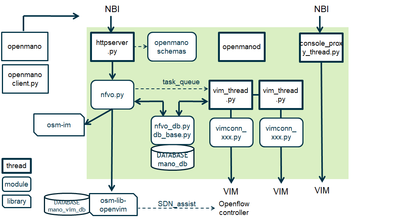Developer HowTo for RO Module: Difference between revisions
| Line 45: | Line 45: | ||
Please follow PEP8 style guide for all the Python code. | Please follow PEP8 style guide for all the Python code. | ||
===Logging=== | |||
Use the appropriate logging levels when logging the messages. An example is shown below: | Use the appropriate logging levels when logging the messages. An example is shown below: | ||
self.log.debug("Changing state to %s", next_state) | self.log.debug("Changing state to %s", next_state) | ||
Logging levels (general and per module) are specified at '''openmanod.cfg''' | |||
===Exceptions=== | |||
Use exceptions for the functions that fails instead of returning a negative or false value. | Use exceptions for the functions that fails instead of returning a negative or false value. | ||
==Directory Organization== | ==Directory Organization== | ||
Revision as of 13:22, 14 October 2016
Getting Started
The prefered Linux distribution is Ubuntu Sever LTS 16.04
Check out the RO module.
git clone https://osm.etsi.org/gerrit/osm/RO
See also and follow Workflow_with_OSM_tools#Clone_your_project
New features must be incorporated to master:
git checkout master
OSM release 1 bug fixes must be done on "v1.0" branch. First time a checkout of this branch is done, use the following to associate local and origin branch
git checkout -b v1.0 origin/v1.0
Generate a ".gitignore", you can use the .gitignore-common example that skip pycharm and eclipse files
cp RO/.gitignore-common RO/.gitignore #edit to include your local files to ignore
Prepare your git environment to push with a proper user/email, push to gerrit. See and configure:
Workflow_with_OSM_tools#Configure_your_Git_environment
Workflow_with_OSM_tools#Commit_changes_to_your_local_project
Workflow_with_OSM_tools#Push_your_contribution_to_Gerrit
Programming Language
The SO module uses Python2. However Python3 conventions for a possible future migration should be used as far as possible. For example:
| BAD Python2 | OK Python3 |
|---|---|
| "format test string %s number %d" % (st, num) | "format test string {} number {}".format(st, num) |
| print a, b, c | print(a,b,c) |
| except Exception, e | except Exception as e |
| if type(x) == X: | if isinstance(x,X): |
Descriptors can be YAML (prefered because more readable and allow comments) or JSON
Code Style
Please follow PEP8 style guide for all the Python code.
Logging
Use the appropriate logging levels when logging the messages. An example is shown below:
self.log.debug("Changing state to %s", next_state)
Logging levels (general and per module) are specified at openmanod.cfg
Exceptions
Use exceptions for the functions that fails instead of returning a negative or false value.
Directory Organization
The code organized into the following high level directories:
- / contains the openmano code
- /test contains scripts and code for testing
- /database_utils contains scripts for database creation, dumping and migration
- /scripts general scripts, as installation, execution, reporting
- /scenarios examples and templates of network scnario descriptors
- /vnfs examples and templates of VNF descriptors
RO Architecture
The RO module contains the following modules
- openmanod.py is the main program. It reads the configuration file (openmanod.cfg) and execute the httpserver and wait for the end
- nfvo.py is the main engine, implementing all the methods for the creation, deletion and management of vnfs, scenarios and instances
- httpserver.py is a thread that implements the northbound API interface, uses python bottle module
- nfvo_db.py is the module in charge of database operations. Uses MySQLdb python module
- openmano_schemas.py is a dictionary schemas used to validate API request and response content using jsonschema library
- vimconn.py is the base class for the VIM connector modules. The inherited vimconn_openstack.py and vimconn_openvim.py implements the connection to these two VIMs. Openstack ones uses the client-python libraris, meanwhile the Openvim ones uses direct http requests
- console_proxy_thread.py is a thread that implements a TCP/IP proxy for the console access to a VIM
Other modules not part of the server are:
- openmnao is a CLI client
- openmanoclient.py is a client python library for managing openmano server
Northbound Interface
The RO uses a REST API with YAML/JSON content. The primitives are explained here
Running Unit Tests
TODO
Creating a new VIM connector
Choose a name, eg. XXX
Create a new python module vimconn_XXX.py derived from vimconn.py class. Implement the relevant functions. You have two already connector created to be used as example, for openstack and openvim. Openstack connector uses the python openstack client libraries, meanwhile openvim connector uses direct http requests.
The new module can need specific configuration that it is passed as a dictionary in the config variable at constructor. For example in the case of openstack it is specify the activation or not of the port_security_enable, teh name of the physical network uses for dataplane, etc. Here you can specify those needed parameters not provided by openmano at network/image/VM creation.
Integration with the main project is automatic, just create a new datacenter of type XXX and this module will be automatically loaded. No other module of the main program need to be updated.
openmano datacenter-create <name> <access-URL> --type=XXX --config <specific config>
#example of <specific config> text: "{dataplane_physical_net: physnet_sriov, port_security_enabled: False}"
openmano datacenter-attach <name> --vim-tenant-name=<tenant-to-use-by-openmano> --user=<tenant-user> --password=<tenant-password>
You can test it using:
#The openmano client : (you will need admin rights to create tenant, flavors,...) ./test_openmanoclient.py -h ./test_openmanoclient.py -t <working tenant> --datacenter <name> --image=<path/url of an testing image> #The vinconnector tester: ./test/test_vimconn.sh -h
